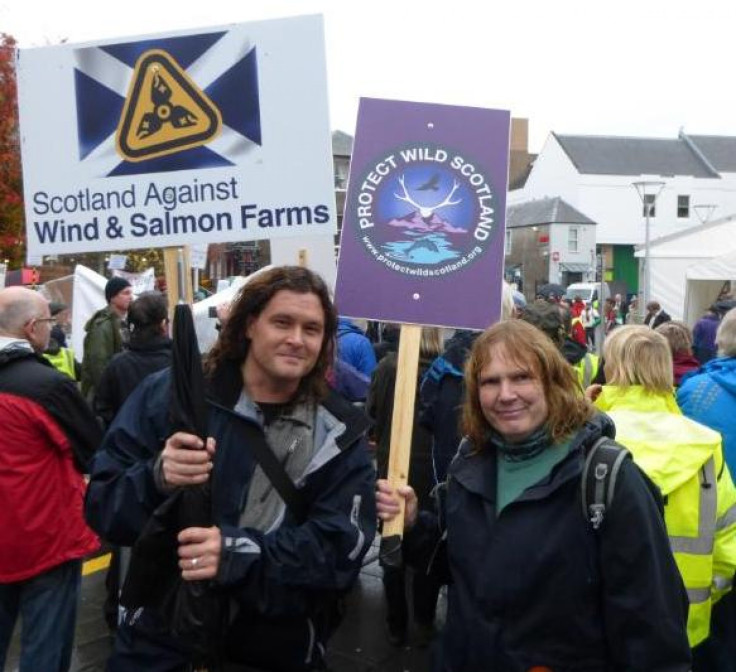Mr. Salmond Promotes Salmon: Scotland’s Push To Increase Seafood Exports To China Raises Maritime Environmental Fears

Scotland’s salmon farming/fishing industry has found itself under enormous pressure to satisfy production targets mandated by China’s seemingly insatiable demand for fresh and smoked versions of the seafood delicacy.
According to a report in the Guardian newspaper of Britain, Scots salmon producers have fallen far behind their goal of raising production by 60,000 metric tons by the year 2020, suggesting the industry may have to skirt some environmental restrictions in order to reach their target. In total, Scottish government ministers promised that total salmon production would reach 210,000 metric tons by 2020 (which is roughly equivalent to China’s total consumption of salmon for the year 2009).
However, due to production stoppages and outbreaks of disease, salmon production in Scotland has been falling – to an estimated 152,500 metric tons in 2013, a drop of 10,000 metric tons from last year alone.
To meet its targets by 2020, salmon production will have to jump by 32 percent in just six years, according to Paul Wheelhouse, Scotland’s environment minister.
"It's a substantial growth that we need to achieve,” Wheelhouse told a conference of the Scottish National Party. “There is already enough capacity consented out there in Scotland for additional fish farms, in theory, to meet that demand. I think it's doable but I can't guarantee it.”
The Guardian noted that some British and Scots fishermen were alarmed by the Scottish government’s salmon deal with Beijing, citing, among other things, that wild salmon were already under threat from sea lice infestation and the potential risks of having escaped farmed salmon cross-breeding with wild salmon.
But China is an increasingly important trade partner for the Scots – in January 2011, the Scottish First Minister Alex Salmond signed a deal with Beijing that would make Scotland the “preferred supplier” of salmon (replacing Norway, in retaliation for the Oslo-based Nobel organization awarding the 2010 Nobel Peace Prize in 2010 Chinese dissident Liu Xiaobo). In exchange, Beijing also made a symbolic gift of donating two giant pandas to the Edinburgh zoo, while also acquiring a large stake in the Grangemouth petrochemical plant and refinery, one of Scotland’s largest industrial sites and biggest employers.
Salmond visited China this past weekend in order to promote Scotland trade with Beijing – he told reporters in Scotland prior to his departure that salmon exports to East Asia have climbed from 2 percent to 19 percent of Scotland’s total overseas exports. More than half of those fish stocks went to China – where Scotland now generates about £20 million ($31.9 million) annually from fish exports. Overall, Scottish exports to China have jumped by 45 percent since the Scottish Government unveiled its “China Plan” in 2006.
Scottish environmentalists are now concerned that the government’s push to increase fish exports (principally through “fish farming”) will lead producers to disregard strict environmental safeguards.
"There is a real danger that this government target could drive Scotland's salmon farmers to become less sustainable, not more," said Lang Banks, Scotland director for the World Wildlife Fund.
Similarly, Don Staniford, a campaigner against fish farms and director of the Protect Wild Scotland group warned that: "Scottish salmon farming is dead in the water with production actually decreasing due to infectious diseases, sea lice infestation and mass mortalities. Yes, the salmon farms in Scotland are all in the wrong place – they should be located close to the market in Asia and the United States."
According to WWF, Scotland is the third largest salmon producer in the world, an industry worth about £500 million per year. But Protect Wild Scotland warns that the increased practice of salmon farming poses grave threats to the environment and to human health. Among other things, they cite that feces and other waste from salmon farms pollute Scotland’s famed lochs; sea lice runs rampant in salmon farms, which endanger and kill sea trout and wild salmon; while chemicals placed in waters to treat sea lice contaminate shellfish.
© Copyright IBTimes 2024. All rights reserved.











